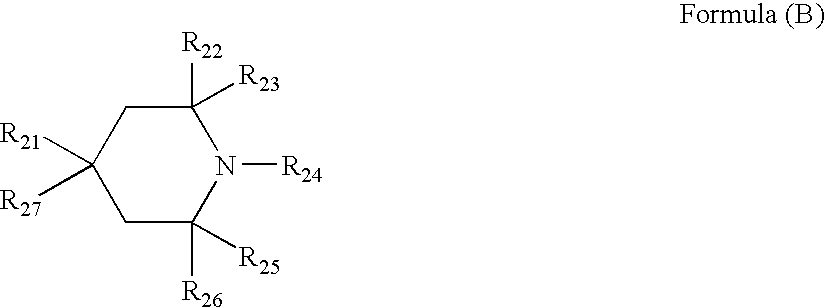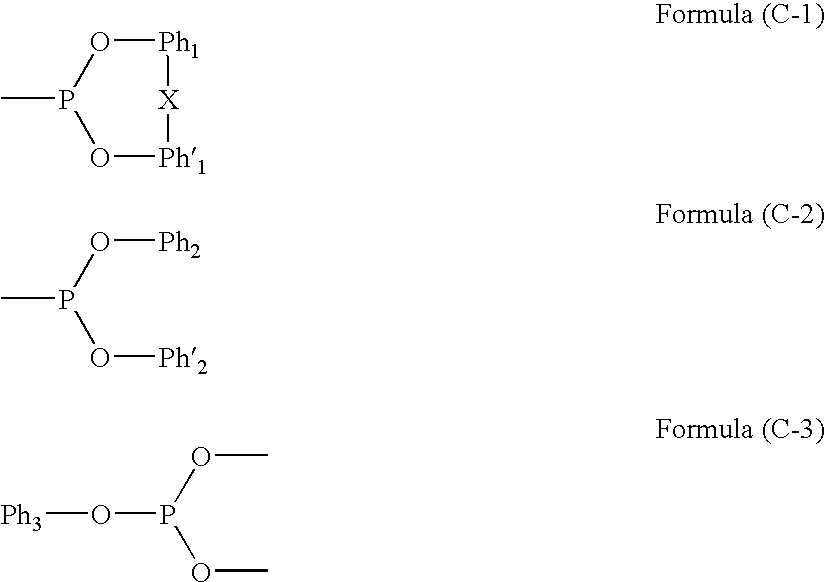Cellulose Ester Film, Process for Producing Cellulose Ester Film, Optical Film, Polarization Plate and Liquid Crystal Display Unit
a technology of cellulose ester film and cellulose ester film, which is applied in the direction of instruments, other domestic objects, transportation and packaging, etc., can solve the problems of difficult industrial realization of such a method, insufficient dissolving ability of substituable solvents, and large burden on the cost of recovering solvents, and achieve excellent retardation uniformity
- Summary
- Abstract
- Description
- Claims
- Application Information
AI Technical Summary
Benefits of technology
Problems solved by technology
Method used
Image
Examples
example 1
[0245]The following cellulose ester was washed by the following procedure.
[0246](Synthesis of Cellulose Ester)
[0247](Cellulose Ester C-1)
[0248]Cellulose acetate propionate CAP-482-20, manufactured by Eastman Chemical Co., was used.
[0249](Cellulose Ester C-2)
[0250]Cellulose acetate butylate CAB-171-15, manufactured by Eastman Chemical Co., was used.
[0251](Cellulose Ester C-3)
[0252]Cellulose ester C-3 was synthesized by the method described in Example B of Item 8 of Patent Publication 7. Thus obtained cellulose acetate propionate had an acetyl substitution degree of 1.90, a propionyl substitution degree of 0.71, a number average molecular weight of 70,000, a weight average molecular weight of 22,000 and a molecular weight distribution of 3.1.
[0253](Measurement of Molecular Weight of Cellulose Ester)
[0254]The average molecular weight and the molecular weight distribution of the cellulose ester can be measured by a high performance liquid chromatography and the weight average molecular ...
example 2
[0305]Washed cellulose ester film samples C-2-1 to C-2-43 were prepared in the same manner as in Example 1 except that the kind and the amount of cellulose ester, solvent and AO agent, and additive were changed as shown in Table 4. And then cellulose ester films 2-1 to 2-43 having a thickness of 80 μm were prepared by using the above washed cellulose esters, respectively.
[0306]The compounds listed in Tables 3 and 4 were as follows.
[0307]Chimassorb 944: Manufactured by Ciba Specialty Chemicals Inc.
[0308]Cyaasorb UV-3529: Manufactured b Cytec Industries Inc.
[0309]Irgafos P-EPQ: Manufactured by Ciba Specialty Chemicals Inc.
[0310]Irgafos 12: Manufactured by Ciba Specialty Chemicals Inc.
TABLE 3WashedcelluloseCelluloseesteresterSolvent*1Solvent*1AO agent 1*1AO agent 2*1RemarksC-2-1C-1Methanol500——Tinuvin7700.5——Inv.C-2-2C-1Methanol500——ADK STAB LA-520.5——Inv.C-2-3C-1Methanol500——CHIMASSORB9440.5——Inv.C-2-4C-1Methanol500——Cyasorb UV-35290.5——Inv.C-2-5C-1Methanol500——Tinuvin7700.2Irganox101...
example 3
[0317]Washed cellulose ester film samples C-3-1 to C-3-36 were prepared in the same manner as in Example 1 except that the kind and the amount of cellulose ester, solvent and OA agent, and additive were changed as shown in Tables 6 and 7. And then cellulose ester films 3-1 to 3-36 having a thickness of 80 μm were prepared by using the above washed cellulose esters, respectively.
TABLE 6WashedcelluloseCelluloseesteresterSolvent*1Solvent*1AO agent 1*1AO agent 2*1RemarksC-3-1C-1Methanol500——Tinuvin1440.5——Inv.C-3-2C-1Methanol500——Sanol LS-26260.5——Inv.C-3-3C-1Methanol500——Compound 30.5——Inv.C-3-4C-1Methanol500——Compound 190.5——Inv.C-3-5C-1Methanol500——Tinuvin1440.4Irganox10100.1Inv.C-3-6C-1Methanol500——Tinuvin1440.4Tinuvin7700.1Inv.C-3-7C-1Methanol500——Tinuvin1440.4PEP-360.1Inv.C-3-8C-1Methanol500——Tinuvin1440.4SumilizerTPL-R0.1Inv.C-3-9C-1Methanol500——SumilizerGP0.5——Inv.C-3-10C-1Methanol500——Compound A0.5——Inv.C-3-11C-1Methanol500——SumilizerGP0.4Irganox10100.1Inv.C-3-12C-1Methanol500—...
PUM
| Property | Measurement | Unit |
|---|---|---|
| boiling point | aaaaa | aaaaa |
| boiling point | aaaaa | aaaaa |
| temperature | aaaaa | aaaaa |
Abstract
Description
Claims
Application Information
 Login to View More
Login to View More - Generate Ideas
- Intellectual Property
- Life Sciences
- Materials
- Tech Scout
- Unparalleled Data Quality
- Higher Quality Content
- 60% Fewer Hallucinations
Browse by: Latest US Patents, China's latest patents, Technical Efficacy Thesaurus, Application Domain, Technology Topic, Popular Technical Reports.
© 2025 PatSnap. All rights reserved.Legal|Privacy policy|Modern Slavery Act Transparency Statement|Sitemap|About US| Contact US: help@patsnap.com



